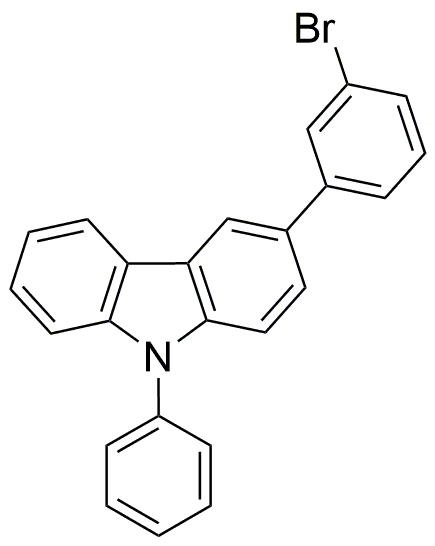3-(3-Bromophenyl)-9-phenyl-9H-carbazole is widely utilized in research focused on:
- Organic Electronics: This compound is used in the development of organic light-emitting diodes (OLEDs), which are essential for creating high-quality displays in televisions and smartphones.
- Photovoltaic Cells: It plays a role in the formulation of organic solar cells, enhancing their efficiency and stability, which is crucial for renewable energy applications.
- Fluorescent Dyes: The compound serves as a fluorescent dye in biological imaging, allowing researchers to visualize cellular processes with high precision.
- Pharmaceutical Research: It is investigated for potential therapeutic applications, particularly in cancer treatment, due to its unique structural properties that may inhibit tumor growth.
- Material Science: This chemical is used in the synthesis of advanced materials, contributing to the development of new polymers with improved mechanical and thermal properties.
General Information
Properties
Safety and Regulations
Applications
3-(3-Bromophenyl)-9-phenyl-9H-carbazole is widely utilized in research focused on:
- Organic Electronics: This compound is used in the development of organic light-emitting diodes (OLEDs), which are essential for creating high-quality displays in televisions and smartphones.
- Photovoltaic Cells: It plays a role in the formulation of organic solar cells, enhancing their efficiency and stability, which is crucial for renewable energy applications.
- Fluorescent Dyes: The compound serves as a fluorescent dye in biological imaging, allowing researchers to visualize cellular processes with high precision.
- Pharmaceutical Research: It is investigated for potential therapeutic applications, particularly in cancer treatment, due to its unique structural properties that may inhibit tumor growth.
- Material Science: This chemical is used in the synthesis of advanced materials, contributing to the development of new polymers with improved mechanical and thermal properties.
Documents
Safety Data Sheets (SDS)
The SDS provides comprehensive safety information on handling, storage, and disposal of the product.
Product Specification (PS)
The PS provides a comprehensive breakdown of the product’s properties, including chemical composition, physical state, purity, and storage requirements. It also details acceptable quality ranges and the product's intended applications.
Certificates of Analysis (COA)
Search for Certificates of Analysis (COA) by entering the products Lot Number. Lot and Batch Numbers can be found on a product’s label following the words ‘Lot’ or ‘Batch’.
*Catalog Number
*Lot Number
Certificates Of Origin (COO)
This COO confirms the country where the product was manufactured, and also details the materials and components used in it and whether it is derived from natural, synthetic, or other specific sources. This certificate may be required for customs, trade, and regulatory compliance.
*Catalog Number
*Lot Number
Safety Data Sheets (SDS)
The SDS provides comprehensive safety information on handling, storage, and disposal of the product.
DownloadProduct Specification (PS)
The PS provides a comprehensive breakdown of the product’s properties, including chemical composition, physical state, purity, and storage requirements. It also details acceptable quality ranges and the product's intended applications.
DownloadCertificates of Analysis (COA)
Search for Certificates of Analysis (COA) by entering the products Lot Number. Lot and Batch Numbers can be found on a product’s label following the words ‘Lot’ or ‘Batch’.
*Catalog Number
*Lot Number
Certificates Of Origin (COO)
This COO confirms the country where the product was manufactured, and also details the materials and components used in it and whether it is derived from natural, synthetic, or other specific sources. This certificate may be required for customs, trade, and regulatory compliance.


